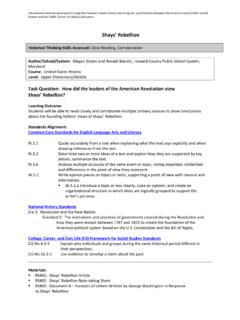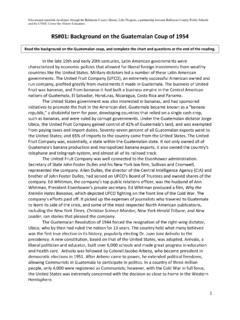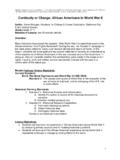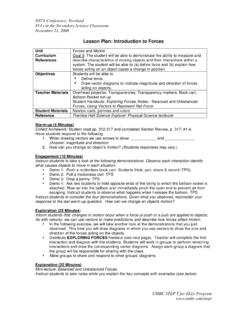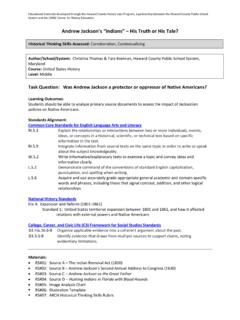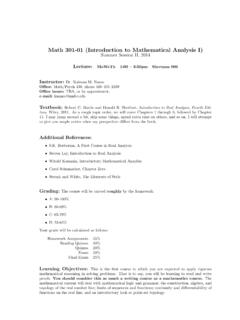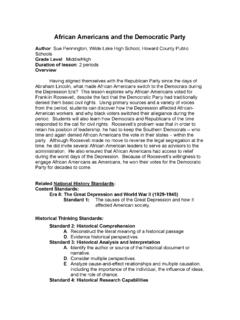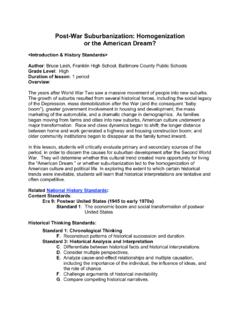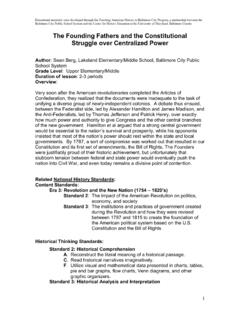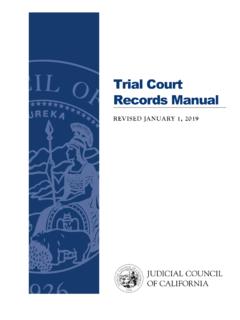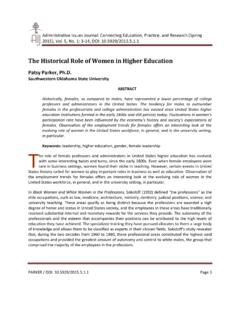Transcription of Brown v. the Board of Education Success or Failure?
1 Brown v. the Board of Education : Success or Failure? Author: Jamie S. Binder, Franklin High School, Baltimore County Public SchoolsGrade Level: Middle/HighDuration of lesson: 1-2 periodsOverview:Now fifty years old, the Supreme Court s Brown v. Board of Education decision iscommonly represented as the case that set racial integration in motion in the UnitedStates. But in the mid-1950s, actual student integration was in fact decades away inmost states, and even today it remains an ongoing, complex process. This lessonillustrates, through six post- Brown court cases, the social and legal realities that greetedblack students who attempted to enroll in traditionally all-white schools. FromCharlottesville, Virginia, to Boston, Massachusetts, local politicians and parent groupsfought the Supreme Court s injunction tooth and nail.
2 Private schools (funded partiallywith public revenue) sprung up for the purpose of preserving an all-white student South Boston, angry white students threw rocks at newly bussed black students whoarrived from their neighborhood of Roxbury. Eventually, though, additional SupremeCourt decisions, demanding the enforcement of a unitary system of public schoolingunder the terms of the 14th Amendment, forced resistant communities to comply with themeasures to desegregate America s students. By exploring the legal documents, pressreports, and personal accounts of the era, students will discover the social conditionsthat made integration into perhaps the fiercest battle of the Civil Rights National History Standards:Content Standards:Postwar United States (1945 to early 1970s)Standard 4: The struggle for racial and gender equality and theextension of civil libertiesHistorical Thinking Standards:Standard 2: Historical ComprehensionA.
3 Reconstruct the literal meaning of a historical Identify the central question(s) the historical narrative 3: Historical Analysis and InterpretationB. Compare and contrast differing sets of ideas, values, personalities,behaviors, and Consider multiple 4: Historical Research CapabilitiesA. Formulate historical Interrogate historical 5: Historical Issues-Analysis and Decision-MakingA. Identify issues and problems in the Marshal evidence of antecedent circumstances and contemporaryfactors contributing to problems and alternative courses of Objectives: Students will identify reactions to Brown v. Board of Education . Students will evaluate the extent to which Brown was successful indesegregating American Education .
4 Students will evaluate the role of the judiciary in affecting societal Background:On May 17, 1954, the Supreme Court of the United States handed down a decisionthat would irrevocably change the nature of race relations in America. In Brown v. theBoard of Education of Topeka, Kansas, 349 294, the Court ruled that the conceptof separate but equal had no place in American life or jurisprudence, in effect,nullifying the legality of segregation that had been established in the 1896 decisionPlessy v. Ferguson. Writing the unanimous opinion, Chief Justice Earl Warren citedthat American s system of segregated schools was inherently unequal under the 14thAmendment s Equal Protection Clause.
5 Many supporters and leaders of the CivilRights movement, including the future Civil Rights leader Martin Luther King, praisedthe promise contained within Brown , calling it simple, eloquent, and unequivocal and a joyous daybreak to end the long night of enforced segregation (Orfield, 5). However,even as King lauded the achievement of Brown as one step closer to the creation of atruly color blind society, he recognized that the road ahead would be a long one, pavedwith resistance and even open defiance (Orfield, 5).Today, at its 50th anniversary, Brown still holds a sacred place among America slandmark Supreme Court cases. Historian Michael Klarman wrote, Constitutionallawyers and historians generally deem Brown v.
6 Board of Education to be the mostimportant Supreme Court decision of the twentieth century, and possibly of alltime (Klarman, 81). As a result, Brown receives much attention in secondary socialstudies classrooms across the country. In 1999, scholars at the University ofWisconsin, Madison found that in the twenty states that contain Supreme Court cases intheir social studies standards documents, Brown was the most commonly included(Hess 276). More interestingly, however, is the way in which Brown is presented tostudents. As one high school teacher explains, Brown is taught because it is such aclear example of how a democracy, when it works the way it is supposed to, can makeprogress.
7 It is obvious to my students that segregation was wrong and that the Courtwas right few things in our history are just so manifestly good (Cushman, 275).Although many scholars, historians, and educators alike affirm the essence of theteacher s statement, they might also offer a reminder that the legacy and iconization ofBrown is controversial and facing academic assault. King s expectation andrecognition of resistance to Brown should not be forgotten within the secondary socialstudies classroom, for we want to convey to our students a complete picture of thestruggle for integration of American schools and the impact of integration way to remedy this misrepresentation of Brown as a slam dunk SupremeCourt case is to provide students with conflicting evidence from the historical record, aswell as current research on levels of integration, and pose difficult and troublingquestions about precisely how much impact Brown really had on American life (Cushman, 275).
8 These questions should include: How did geography, race, socio-economic status, gender, and political ideology influence reactions to Brown ? Whatmethods were utilized to resist Brown ? How quickly did school systems move todesegregate following the Brown ruling? Was Brown the most effective means bywhich to integrate Education and ultimately the American way of life? What role did thejudiciary play in desegregation, and finally was Brown successful in achieving its goal ofequal protection under the law for all Americans? A survey, spanning the last fiftyyears, of six cases in the struggle for desegregation can enable students to beginasking these difficult and troubling questions and develop a more nuancedunderstanding of Brown and its legacy students can examine Brown s legacy they must first examine immediatereactions to Brown and the historical context for these reactions.
9 Perhaps the most theinfamous battle over the Brown ruling occurred in September of 1957 at Central High inLittle Rock, Arkansas. Governor Orval Faubus, amid threats of violence and disorderamong citizens, declared that he would block any attempts to integrate Central. Trueto his word, on September 2, Faubus ordered the Arkansas National Guard to CentralHigh. His action initiated a constitutional crisis over the extent of state power versusfederal authority. After three weeks of legal wrangling and an unsuccessful meetingwith Eisenhower in Washington, Faubus replaced the Guard with local police, but onSeptember 23 when nine black students attempted to enter the school amid an angryprotest, rioting erupted.
10 The nine black students were denied entrance and escortedhome, according to the chief of police, for their own safety. Recognizing the severityof the explosive situation, Little Rock s mayor petitioned Eisenhower to send federaltroops to restore order. On September 25, with the arrival of the 101st Airborne, LittleRock looked more like a city under siege than a quiet southern community. As armedtroops secured Central High and military helicopters flew overhead, the nine blackstudents, accompanied by military personnel, finally entered the school (Jacoway, 8).While the remainder of the school year passed without violence, and Ernest Greenquietly earned the distinction as the first black graduate of Central High on May 27,1958, the struggle over integration continued in the courts.
